As portable and hand-held spectrometers continue to trend up, manufacturers face new challenges in analysis and support.
FAROOQ AHMED, SCIENCE WRITER
Spurred by manufacturing advancements over the past decade, lasers, sensors, and imaging devices have become more compact and reliable. This progress has allowed spectroscopy to grow into new and diverse fields. The tabletop semiconductor laser, the benchtop FTIR (Fourier transform infrared) and hand-held x-ray fluorescence (XRF) spectrometers, and the advent of silicon photonics are opening new areas of inquiry and industry — often for individuals untrained in spectroscopy.
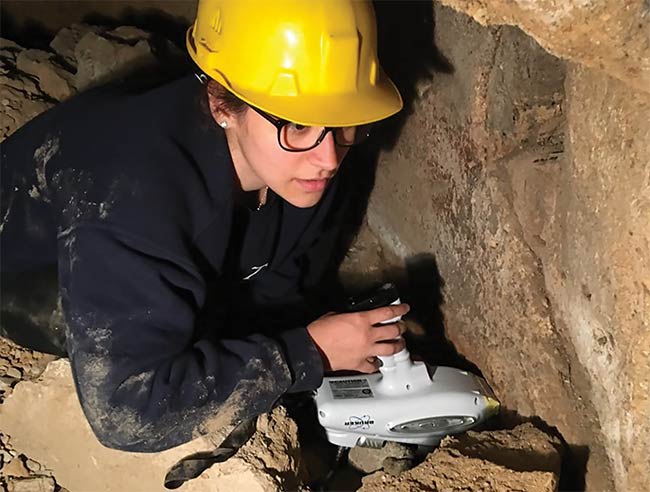
A student collects XRF data from the walls of an underground cistern at the Cavità 254 excavation site in Orvieto, Italy. Courtesy of Mary Kate Donais.
Protein structure
One area in which this convergence of technologies can be seen is spectroscopy for protein structure determination. The field itself is not new and dates back at least to Nobel laureate Kurt Wüthrich’s work in the 1970s using NMR (nuclear magnetic resonance) spectroscopy to investigate biological macromolecules. More recently, IR and FTIR spectroscopy have allowed structural biologists to uncover the secondary structure of proteins of nearly any size. The key has been to study the absorption of amide groups in amino acids with wave numbers between 1600 and 1700 cm−1, which is also known as the amide I band. In this range, structures like alpha helices and beta sheets reveal themselves.
The tabletop semiconductor laser, however, has fundamentally changed what biologists can accomplish. One company that has exploited the utility of the quantum cascade laser is RedShiftBio, headquartered in Burlington, Mass. Jeffrey Zonderman, the company’s chief commercial officer, said that five to 10 years ago, it didn’t make a lot of sense to put a laser on a benchtop. “They were … finicky, and they were very expensive,” he said. “[But now] the value proposition meets the need.”
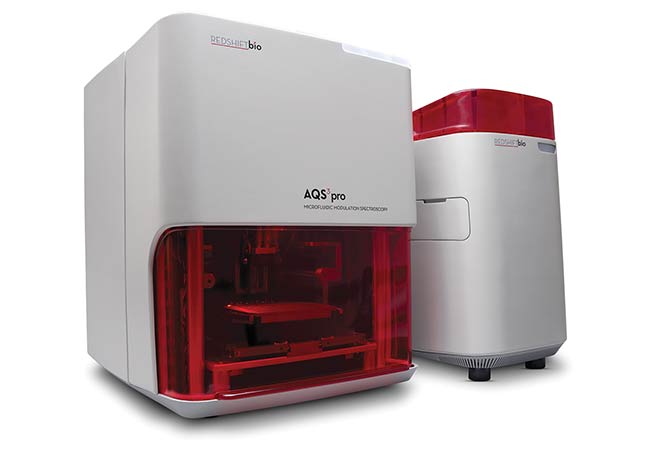
Figure 1. RedShiftBio’s AQS3pro uses a quantum cascade laser for microfluidic modulation spectroscopy to determine protein structure. Courtesy of RedShiftBio.
In April 2018 at the PEGS protein engineering conference in Boston, RedShiftBio unveiled its benchtop instrument for characterizing soluble proteins — the AQS3pro (Figure 1). The device combines tunable lasers with microfluidics, which the company has termed microfluidic modulation spectroscopy (MMS). The AQS3pro passes laser light through a microfluidic cell that alternates reference buffer and target sample at high speed. A mercury cadmium telluride IR detector absorbs the light, and software subtracts the buffer from the sample to produce information on protein structure and related characteristics such as concentration, stability, and aggregation.
“We’re taking IR [spectroscopy] and moving it to a flow cell,” said Zonderman. “That’s never really been possible before with IR.”
An advantage, he said, is that protein concentrations can be measured over a wide range — from 0.1 mg/mL to over 200 mg/mL. Initial research on IgG and bovine serum albumin structure performed by RedShiftBio in conjunction with New York’s Pfizer and Colorado’s Elion Labs supported the company’s claims1.
Zonderman believes that RedShiftBio’s instrument is a platform technology that in the future could be used to detail the structure of other biological macromolecules, such as nucleic acids. “Our focus right now is on biotherapeutic proteins and doing biophysical characterization,” he said. “But this platform also allows us to look at other molecule types for sure.”
The instrument, he said, is capable of running fully automated, and he added that it benchmarks very closely with instruments such as FTIR.
Art conservation
FTIR itself has made deep inroads into the art market. Whether in conservation, restoration, or counterfeit detection, analytical techniques have allowed conservators to noninvasively probe priceless works of art, detailing the composition of the paints, dyes, lacquers, and other chemical components of the works.
“We can accurately identify the type of paint or pigment [to] very quickly know if a painting is a copy or the original work of art,” said Matt Gundlach, product manager for FTIR spectrometers at Waltham, Mass.-based Thermo Fisher Scientific.
At Pittcon 2018 in Orlando, Fla., Thermo Fisher debuted the ConservatIR FTIR External Reflection Accessory (Figure 2), which attaches to its benchtop Nicolet FTIR spectrometers.
Gundlach said the product fits into the sample compartment of the spectrometer and uses a series of mirrors to bring the IR light toward the painting and then re-collect the reflected light back toward the instrument.
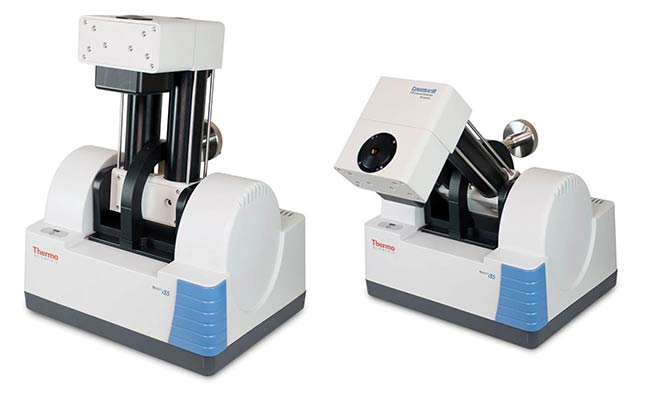
Figure 2. Thermo Fisher’s ConservatIR FTIR External Reflection Accessory allows art conservationists to inspect priceless works of art in situ. Courtesy of FisherThermo.
The global art market has been reported to be worth upward of $200 billion — and nearly 12 percent ($6 billion) of those transactions are suspected of involving illicit activity. In 2016, the venerable international art auction house Sotheby’s purchased Orion Analytical, a materials analysis and consulting firm in Williamstown, Mass., and appointed its founder, James Martin, senior vice president and director of scientific research. Reached by email, Martin said that routine use of IR spectroscopy in conservation science labs began in the 1980s with the introduction of commercial FTIR spectrometers coupled to optical microscopes. Portability, he said, has allowed Sotheby’s to conduct analyses in the field when works of art cannot be moved to labs in New York or London.
In a demonstration at Pittcon, Thermo Fisher’s Gundlach identified the pigments of an American painting from the mid-1900s without removing any paint. “Historically, conservationists would actually take a piece of the painting and scrape it off,” he said, “and then they would take it to an instrument [for] analysis.” The ConservatIR accessory, he said, can be placed millimeters from the artwork and collect data without touching it.
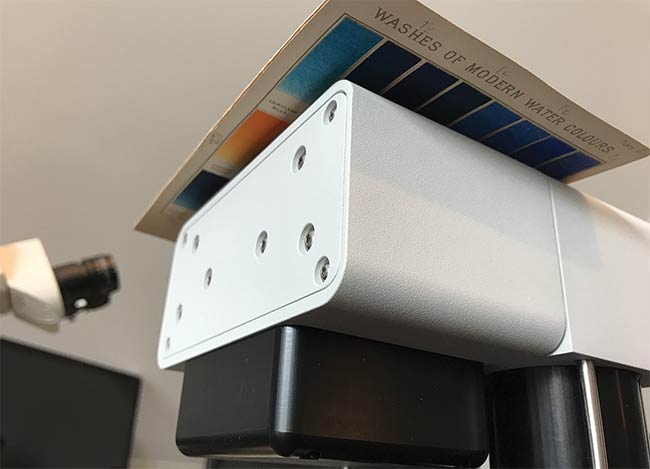
Figure 3. The ConservatIR, positioned upright, measures historic paint samples from the 1880s. Courtesy of Sotheby’s Department of Scientific Research.
Martin concurred. He said the Thermo Fisher accessory has allowed his group to make first-pass analyses of larger areas without samples (Figure 3). He sees manufacturers looking to exploit niche areas such as conservation science, “where portability and lower cost will yield new and increased sales.”
Archaeological surveys
“Portability for us is essential,” said Mary Kate Donais, professor of chemistry at Saint Anselm College in Manchester, N.H., and former president of the Society for Applied Spectroscopy.
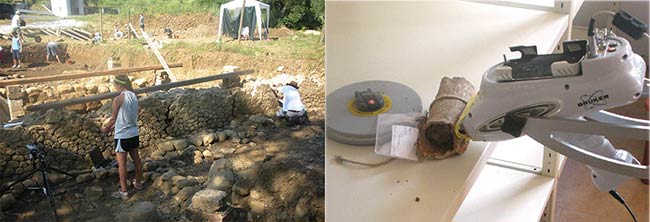
Figure 4. A student collects XRF data on wall mortars at a site in Corigliano, Italy (left); and a hand-held XRF collects data on a section of lead pipe at an excavation lab (right). Courtesy of Mary Kate Donais.
An early adopter of portable spectrometers for archaeology, Donais carries hand-held XRF devices to dig sites in Italy (Figure 4). Hand-held XRF has been widely used in industrial applications such as mining and environmental cleanup for nondestructive elemental and chemical analyses.
Handhelds make up the majority of the global XRF market and are the fastest-growing product type.
Donais credits her Saint Anselm colleague and frequent collaborator, David George, a professor of classics, with approaching her to integrate analytical techniques into archaeology. “He saw his field changing,” she said.
Donais and George have investigated Roman and Etruscan artifacts such as glass tesserae, floor tiles, frescoes, walls, coins, and loom weights for weaving, often in situ, near the city of Orvieto in central Italy. The collaboration, she said, has been fruitful. “We have chemical information that can be combined together with [archaeologists’ observations] to either strengthen a conclusion or maybe question if it’s correct or not.”
As in art conservation, portable instruments are crucial in situations where objects cannot be removed from sites — or be moved out of the country. Donais and colleagues investigated the collapsed floors of an ancient Roman building. “By using the [hand-held] XRF and analyzing each of the floors, we found that they were chemically different — different floors — without further excavation,” she said.
Handhelds make up the majority of the global XRF market and are the fastest-growing product type. Their sales are expected to continue to grow at a compound annual growth rate of more than 5 percent from 2018 to 20272.
Portable XRF, together with other portable spectroscopies, such as LIBS (laser-induced breakdown spectroscopy), is increasing in use in field archeology, Donais said. “The affordability of many of these instruments is also a plus,” she added. While LIBS can detect some elements not covered by XRF, the technique is minimally destructive, which is not ideal for unique artifacts or artworks. Nondestructive portable Raman spectroscopy has also made inroads into archeology, although portable XRF remains the standard.
Setting standards
Using these devices to generate meaningful data remains a hurdle. All experiments require proper controls, but according to Donais, calibration is very challenging because it’s very matrix-specific. “If you want to get accurate, quantitative results, and you’re measuring glass samples, you have to have glass standards,” she said. “How am I going to obtain a standard for an Etruscan loom weight? It doesn’t exist.”
Additionally, access to portable devices by nontrained professionals — the widespread adoption of spectroscopy — has prompted a set of concerns around data quality, reference standards, and product usability. Thermo Fisher’s Gundlach agrees. “Where we used to have very skilled spectroscopists purchasing and using our instruments,” he said, “that’s really shifted now to having people who are proficient in a number of different techniques.”
This new reality has forced instrument manufacturers to redesign hardware and software, develop and maintain relevant sample libraries, and offer courses to nonspecialists. “This effort spans multiple markets,” said Gundlach.
RedShiftBio’s Zonderman said that with the AQS3pro, users can select from a spectral library of known proteins for comparison and that default settings are provided for the nonexpert.
Donais’ solution was to develop stringent protocols and do comparison studies. “It’s so easy to take this [XRF] gun, and just go and zap stuff,” she said. “You can have a whole bunch of data that you really have a hard time drawing any confident conclusions [from]. That’s where my strength as a trained analytical chemist [came into use].”
Although tabletop and portable hand-held spectrometers currently dominate the field, silicon-based and nanoscale IR devices are on the rise. They represent a convergence of manufacturing and utility that could enable the widespread deployment of spectrometers for niche applications.
Silicon photonic spectrometers
In December 2014, the U.S. government’s Advanced Research Projects Agency-Energy (ARPA-E) announced the program Methane Observation Networks with Innovative Technology to Obtain Reductions (MONITOR). Armonk, N.Y.-based IBM, in collaboration with Princeton and Harvard universities, teamed up to compete in the initiative.
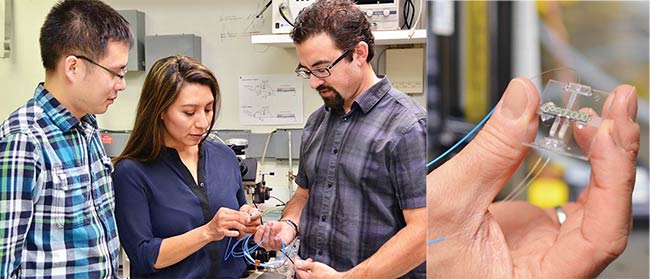
Figure 5. IBM researchers prepare a sensor for testing in the lab (a); this sensor design uses silicon photonics to detect methane with IR light brought in via optical fibers (b). Courtsey of IBM Research
Will Green, senior manager of Materials, Devices, and Integrated Systems at IBM’s T.J. Watson Research Center, and his colleagues designed a silicon chip sensor to detect fugitive methane emissions in natural gas production at 1650 nm (Figure 5). He said the sensor is basically “a tunable diode laser absorption spectrometer [that] allows us to really be
selective to the gas of choice.” The chip has a target methane concentration sensitivity of 10 ppm in a 1-s measurement.
Although they can be limited in full-spectrum spectroscopy applications, silicon-based devices have several advantages over traditional ones, including fabrication processes that allow for hybrid optical-electronic components at low costs. According to Green, because the chip is silicon-based, it allows IBM to create a sensor and manufacture it in volume — to meet the needs of the oil and gas sector as well as reach a low market price of $50 to $100, as opposed to conventional tunable diode laser absorption spectrometers that might cost up to $10,000.
The silicon photonics market is itself poised for rapid growth. It is predicted to reach a value of $560 million at the chip level in 2025 (from $30 million in 2016) and nearly $4 billion at the transceiver level, with most of the growth in data centers3.
Green sees the silicon photonic gas sensors — such as the one his team built for methane — deployed in other areas, including in-cabin air quality monitoring
for vehicles and eventually in the biomedical space where doctors may be able to affordably perform diagnostics in the office that today would need to be sent out to labs.
In March 2019 at the Optical Networking Communication Conference & Exhibition (OFC) in San Diego, Green will lead a symposium on photonics for the Internet of Things and sensing, during which he and others will discuss the synergies that have emerged from the combination of these fields.
www.linkedin.com/in/farooqtheahmed
Acknowledgments
The author would like to thank Jeffrey Zonderman, RedShiftBio; Matt Gundlach, Thermo Fisher Scientific; James Martin, Sotheby’s; Mary Kate Donais, Saint Anslem College; and Will Green, IBM.
References
1. www.redshiftbio.com/learn-more.
2. www.marketresearch.biz/report/x-ray-fluorescence-market.
3. www.i-micronews.com/images/Flyers/Photonics/Yole_Silicon_Photonics_2018_flyer.pdf.